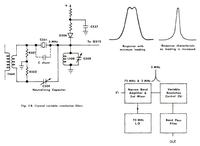neazoi
Advanced Member level 6
hello,
I have made this mini transmitter

The problem is that when I measure the signal on the spectrum analyzer using maximum resolution (1khz on my analyzer), the top of the signal is as shown and the signal shows a bandwidth of 100KHz at -3db.
When I reduce the resolution, the signal shows a cleaner top and much less occupying bandwidth but still lot.
I thought that an unmodulated carrier occupies only a few HZ or 10s of Hz, am I wrong?
Also what about the effect of the resolution on the top of the signal, is that normal?
I have made this mini transmitter

The problem is that when I measure the signal on the spectrum analyzer using maximum resolution (1khz on my analyzer), the top of the signal is as shown and the signal shows a bandwidth of 100KHz at -3db.
When I reduce the resolution, the signal shows a cleaner top and much less occupying bandwidth but still lot.
I thought that an unmodulated carrier occupies only a few HZ or 10s of Hz, am I wrong?
Also what about the effect of the resolution on the top of the signal, is that normal?
Last edited:

